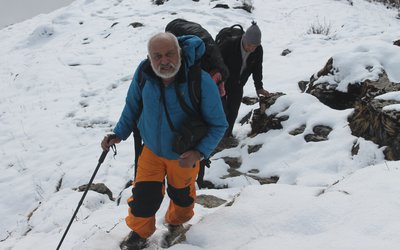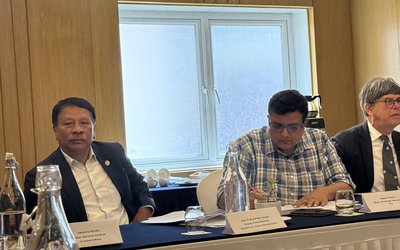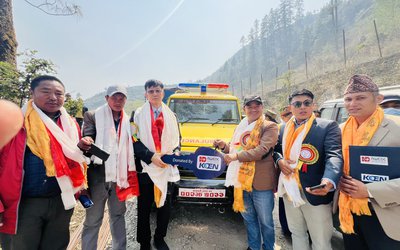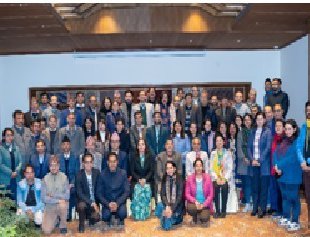
The fifth session of the Conference of the Parties (CoP) serving as the meeting of the Parties to the Paris Agreement (CMA.5) held during CoP28 to the UNFCCC at Dubai has made several decisions to expedite the implementation of adaptation options to reduce climate vulnerability, strengthen resilience and build adaptive capacity. On water stream, the first global stocktaking (GST1) has recognised "the critical role of protecting, conserving and restoring water systems and water-related ecosystems in delivering climate adaptation benefits and co-benefits, while ensuring social and environmental safeguards". In line with the call of CMA.5 on adaptation, Nepal may wish to increase ambition and enhance adaptation actions at scale and at local levels to, inter alia, "significantly reduce climate-induced water scarcity and enhance climate resilience to water-related hazards ..." by 2030.
Nepal, a least developed, mountainous, and land-linked country, is implementing most urgent and immediate adaptation interventions as prioritised in the National Adaptation Programme of Action (NAPA) based on observed and perceived climate change impacts, national circumstances, needs and priorities. Nepal issued a National Framework on Local Adaptation Plan for Action (LAPA) in 2011 to localise adaptation options.
Urgency of implementing adaptation options was further realised at the global level. In 2010, Parties to the UNFCCC decided to prepare and implement the National Adaptation Plan (NAP) to address medium and long-term adaptation needs in developing countries. As of CoP28, 51 developing country Parties to the UNFCCC, including Nepal have prepared NAPs. Countries have prioritised both community-based and ecosystem-based approaches to implement adaptation options to reduce a range of climate change risks, address the needs of the climate vulnerable, and provide multiple co-benefits.
In 2011, the UK government provided support to implement the most urgent and immediate adaptation options as prioritised in Nepal's NAPA using the LAPA framework in climate-vulnerable districts of mid-west and far west Nepal. The UK government continued its support to localise adaptation options and improve the socio-economic conditions of the climate-vulnerable communities through the Nepal Climate Change Support Programme (NCCSP).
Revisiting the concept and approach of supporting the needy people and communities, NCCSP at its second phase continued its support on 'demand-driven', people-centric, and income-generating adaptation options taking note of the climate vulnerability of the municipalities as ranked in the Vulnerability and Risk Assessment (VRA) report prepared as a part of NAP formulation process by the Ministry of Forests and Environment (MoFE) - the climate change focal point of Nepal - in 2021. A review of adaptation options informs people's demand on water supply either for drinking or irrigation purposes to meet the drinking water needs and utilise water for economic benefits by raising vegetables. The linkage of water demand with production is advancing towards economic and ecological security in the adaptation piloting areas. The following paragraphs provide few examples of NCCSP support in addressing water supply as the most prioritised needs of the climate-vulnerable communities in sample districts of Karnali and Sudur Paschim provinces.
Field visit of the following adaptation sites in December 2023 in Surkhet and Kailali districts, implemented with support from NCCSP, offers a message on its approach of ensuring climate-induced effects and future impacts, linking with climate vulnerability and risks based on VRA report and climate rationale, selection of adaptation options using LAPA framework (2019), involvement of marginalised and disadvantaged climate vulnerable communities such as Dalits and janajatis, and approach of supporting through the local user groups under the guidance, coordination and supervision of the concerned municipality:
1 The Attitude Drinking Water scheme at Bheriganga Municipality-4, Surkhet was supported to provide drinking water to marginalised and climate-vulnerable 489 households, affected by drought, landslides, pest infection, and riverbank cutting etc. The required quantity of water is lifted to a vertical height of 80m through the pump and distributed through a storage tank for drinking purposes and other uses.
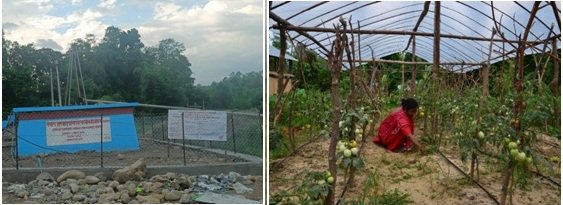
Hattisude Drinking Water Scheme Tomato raising Courtesy: Dinesh Ghimire
2 In Bheriganga Municipality-10, NCCSP supported Kareli lift irrigation scheme has substantially changed the life and livelihood of in-migrated 27 households (with 96% Dalits and janajatis and 52% women) from vegetable production due to irrigation facilities. A small support can bring a remarkable change in generating income, developing entrepreneurship, and improving the livelihoods of the marginalised and 'highly climate vulnerable communities' due to drought.
3 NCCSP support in 'moderately climate vulnerable' Panchapuri Municipality-11 in Surkhet to develop Raji Dhara Drinking Water Supply scheme has substantially contributed to meeting the demand for safe drinking water of marginalised, climate vulnerable, and small farmers, totalling nearly 1600 people of 6 settlements at Thankot Kuine. Roles and responsibilities of the municipality are clear and instrumental in coordinating the support of relevant organisations and enhancing ownership over the water scheme and its operation and maintenance.
4 Again, in Panchapuri municipality-10, Rajigaun (Rudrerowa) water supply scheme is providing drinking water to over 150 climate-vulnerable and resettled people who were severely affected by landslides and floods. Local people have started growing vegetables from unused water and have increased their seasonal income.
5 Climate change projects are designed to reduce climate vulnerability, build adaptive capacity and strengthen resilience to climate change. Community-driven adaptation options are multi-fold and proper selection of actions contributes to multi-purpose use as well. In flood-affected and inundated areas of Tikapur Municipality-3 (Chiya settlement with 5/6 of Dalits, and Janajatis of 150 households), Kailali, local people prioritised actions to protect them and their properties and enhance the adaptive capacity of local people against flood. It resulted in the construction of a disabled (having different capacities) and gender-friendly flood-resilient shelter house. NCCSP supported to construct of the multi-purpose building to protect people from floods and inundations, and use the building for meetings, training and social events, and storing crops during floods and other seasons.
6 Economic upliftment contributes to cope with the adverse impacts of climate change. Coping capacity is sufficiently linked with the purchasing power of an individual or a community. Support of NCCSP for banana farming at Rajapur Municipality, experiencing a high rate of vulnerability due to high exposure, sensitivity and low adaptive capacity, under its Covid-19 Special Partnership Programme has benefitted about 100 people. NCCSP support to a progressive farmer has been instrumental in promoting 'banana farming'. Banana farmers informs greater potential of linking adaptation options with income-generating activities.
NCCSP support in the above six sites calls for helping climate-vulnerable communities to protect them from drought (too little water) to meet their water needs, at least for drinking and irrigation, and 'too much water' to reduce adverse impacts of inundations and flooding. This informs to prioritise climate actions to solve water-related impacts and link adaption interventions for economic security. This also informs the urgency of enhancing adaption capacity to conserve, manage and sustainably utilise water resources to improve people's livelihoods for ecological security.
Looking after the support utilisation approach, municipalities have been engaged in selecting and prioritising adaptation interventions through a 'branded' LAPA, implementing actions through user groups, involving concerned wards in coordination and supervision, utilising benefits through collaborative approaches, and developing the most important element for sustainability - the ownership over the interventions. A decade-long experience in engaging municipalities and local service providers through the 'on-budget, on-treasury' practice of fund flow to climate vulnerable communities provides evidence to empower elected local body - the municipality - for overall priority setting, coordination, supervision, monitoring, and evaluation and involve local beneficiaries - the people - in implementation and maintenance.
Realising the greater impacts of climate change on water resources, the Water and Energy Commission Secretariat (WECS) has coordinated, supervised, guided, and facilitated the preparation of a response strategy for water resources under the Global Water Leadership (GWL) Programme to address key barriers namely, policy implementation, institutional coordination, and data & capacity building prioritised through the multi-stakeholder consultative process. The strategy outlines prioritised root causes of each barrier which ranges from inadequate political will to the lack of coordination at different levels, and data acquisition and sharing policy. Nearly two dozen of strategies have been developed with 29 actions and 76 sub-actions to address challenges that impede inclusive and climate resilient policies and strategies. Effective implementation of the response strategy is expected to substantially contribute to integrate climate change into water resource policies and programmes (climate-smart policies), and water concerns into climate change policies and programmes (water inclusive climate policies). The response strategy was validated by the multi-stakeholders on the second week of January 2024. WECS may process for accessing and mobilising resources for its effective implementation again with multi-stakeholder approaches.
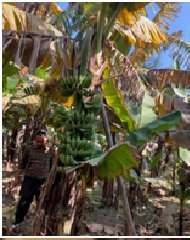

Batu Uprety
Former Joint-Secretary and Chief of Climate Change Management Division, Ministry of Environment (then), and former Team Leader, National Adaptation Plan (NAP) formulation process. E-mail: upretybk@gmail.com
- Sagarmatha Sambad: Likely Bearing the Fruits
- Mar 27, 2025
- Decadal Experience In Preparing The NDC
- Mar 03, 2025
- Over Five Decades Of Concern On Air Pollution
- Jan 16, 2025
- Damaging The Functional EIA Track
- Dec 22, 2024
- Baku CoP29 Outcomes And Nepal's Initiatives
- Nov 26, 2024

